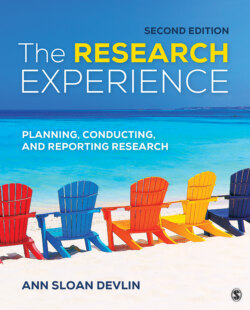Читать книгу The Research Experience - Ann Sloan Devlin - Страница 41
Ideas: The Student Sphere of Activity
ОглавлениеIn Chapter 1, the material presented a number of the biases in thinking and limitations humans have, as well as about some of our strengths, such as common sense. A major source of ideas starts with you and the people and activities in your life. Instructors who teach writing often tell students: “Write about what you know.” The same advice could be directed at researchers: “Study what you know.” You are probably knowledgeable about many spheres of activity that are less familiar to your instructors, whether social media, technology more broadly, or interpersonal relationship protocol among teenagers and young adults. Making a list of ideas or topics that are important in your life and in the lives of your friends is a good way to generate a research topic. This approach also makes sense because the participants in your research will likely be students your age (from your institution) who may be interested in participating in a project about a topic that interests them as well.
In recent semesters in my research methods courses, students have submitted papers on a range of topics including social media use, paranormal beliefs, child-rearing styles, stereotypes surrounding athletes, academic dishonesty, and use of mental health services by college students. Here are some examples of project titles. The numbers on the left represent the categories of research approaches presented in Figure 2.1:
(1) Parental Involvement and Student Academic Achievement
(1) Personality and Attachment Style as Correlates of Facebook Use and the Need to Belong
(2) Relationships Between Birth Order, Gender, Anxiety, and Perceived Parental Control
(3) Race and Long-Distance Dating: Effects on Perceived Relationship Success
(3) College Students’ Attitudes Toward Individuals With Seen and Unseen Disabilities
(3) Think Before You Speak: Perceived Authority of Women’s Voices in the Workplace
(3) Gender Perceptions in Hiring: Effects of Hair Color on Predicted Capabilities of Female Job Applicants
(3) Perceived Femininity of Women Weightlifters
(4) Mental Health of First- and Fourth-Year Students
Description
Figure 2.1 Diagram of Common Research Approaches
These titles are examples of projects done by students taking a course in research methods—for most their first research project. These projects have been divided into four categories (see the numbers in parentheses by the project title; Figure 2.1). These categories will be topics in future chapters. Projects in Category 1 represent what are called correlational projects (there is no manipulation of variables and results are about the sample as a whole; a common correlational statistic is Pearson’s r; see Chapters 3 and 7). Projects in Category 2 are also called correlational in the sense that there is no manipulation of variables, but these projects differ from those in Category 1 in that they include a consideration of group differences. Statistics are typically a t test, analysis of variance, or multivariate analysis of variance, depending on how many groups and outcomes there are (see Chapters 3 and 7). Projects in Category 3 are true experiments. In these projects, variables are manipulated (e.g., the hair color of female job applicants). Statistics are typically a t test, analysis of variance, or multivariate analysis of variance, again depending on how many groups and outcomes there are. Note that the statistics in Categories 2 and 3 are the same, but only in Category 3 are there true experiments (see Chapter 9). Category 4 illustrates a special case of the group difference approach in correlational approach: cross-sectional design. In cross-sectional design, the researcher is typically looking at people (here students) who represent different points of development or maturation, but the data are collected at one point in time because there is no possibility to follow student development over a long period of time in a semester-length project. Cross-sectional research approximates this developmental progression at a single point in time by contrasting students of different class years, for example (see Chapter 7). The end of the book (see Appendix A, Figure A.1) includes a more complete statistical decision tree if you want a refresher on which statistical test is appropriate for several common research approaches.
Institutional review board (IRB): Deliberate body that evaluates research with human subjects; required where institutions receive federal funds for research but typically established at an institution where research is conducted.
Human subjects: With regard to the federal definition (45 CFR 46), involves living individuals from whom the researcher obtains data, including biospecimens, through an interaction or intervention, or about whom the research obtains personally identifiable information or biospecimens.
